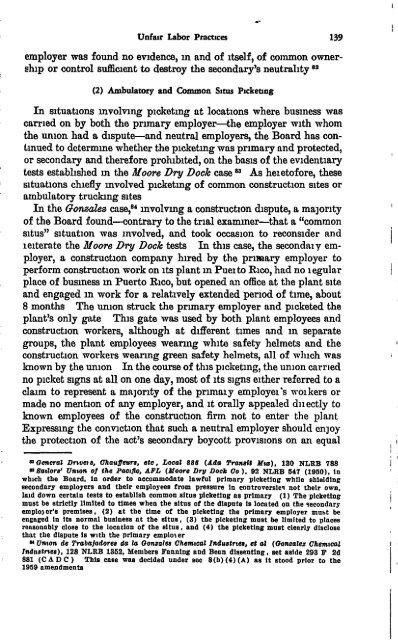TWENTY-SIXTH ANNUAL REPORT - National Labor Relations Board
TWENTY-SIXTH ANNUAL REPORT - National Labor Relations Board
TWENTY-SIXTH ANNUAL REPORT - National Labor Relations Board
Create successful ePaper yourself
Turn your PDF publications into a flip-book with our unique Google optimized e-Paper software.
Unfair <strong>Labor</strong> Practices 139<br />
employer was found no evidence, in and of itself, of common ownership<br />
or control sufficient to destroy the secondary's neutrality 8 2<br />
(2) Ambulatory and Common Situs Picketing<br />
In situations involving picketing at locations where business was<br />
carried on by both the primary employer—the employer with whom<br />
the union had a dispute—and neutral employers, the <strong>Board</strong> has continued<br />
to determine whether the picketing was primary and protected,<br />
or secondary and therefore prohibited, on the basis of the evidentiary<br />
tests established in the Moore Dry Dock case " As heietofore, these<br />
situations chiefly involved picketmg of common construction sites or<br />
ambulatory trucking sites<br />
In the Gonzales case," involving a construction dispute, a majority<br />
of the <strong>Board</strong> found—contrary to the trial examiner—that a "common<br />
situs" situation was involved, and took occasion to reconsider and<br />
ieiterate the Moore Dry Dock tests In this case, the secondary employer,<br />
a construction company hired by the primary employer to<br />
perform construction work on its plant in Puei to Rico, had no iegular<br />
place of business in Puerto Rico, but opened an office at the plant site<br />
and engaged in work for a relatively extended period of time, about<br />
8 months The union struck the primary employer and picketed the<br />
plant's only gate This gate was used by both plant employees and<br />
construction workers, although at different times and in separate<br />
groups, the plant employees wearing white safety helmets and the<br />
construction workers wearing green safety helmets, all of which was<br />
known by the union In the course of this picketing, the union carried<br />
no picket signs at all on one day, most of its signs either referred to a<br />
claim to represent a majority of the primaiy employ& 's woi kers or<br />
made no mention of any employer, and it orally appealed dnectly to<br />
known employees of the construction firm not to enter the plant<br />
Expressing the conviction that such a neutral employer should enjoy<br />
the protection of the act's secondary boycott provisions on an equal<br />
= General Drivels, Chauffeurs, etc , Local 886 (Ada Transit Mix), 130 NLRB 788<br />
gi Sailors' Union of the Pacific, AFL (Moore Dry Dock Cc). 92 NLRB 547 (1950), in<br />
which the <strong>Board</strong>, in order to accommodate lawful primary picketing while shielding<br />
secondary employers and their employees from pressure in controversies not their own,<br />
laid down certain tests to establish common situs picketing as primary (1) The picketing<br />
must be strictly limited to times when the sails of the dispute is located on the secondary<br />
emplo3 er's premises, (2) at the time of the picketing the primary employer must be<br />
engaged in its normal business at the situs • (3) the picketing must be limited to places<br />
reasonably close to the location of the situs , and (4) the picketing must clearly disclose<br />
that the dispute is with the primary emploi er<br />
84 Union de Trabajadorea da la Gonzales Chemical Industries, et al (Gonzalez Chemical<br />
Industries), 128 NLRB 1352, Members Fanning and Bean dissenting, set aside 293 F 2d<br />
881 (CAD C) This ease was decided under sec 8(b) (4) (A) as it stood prior to the<br />
1959 amendments

















